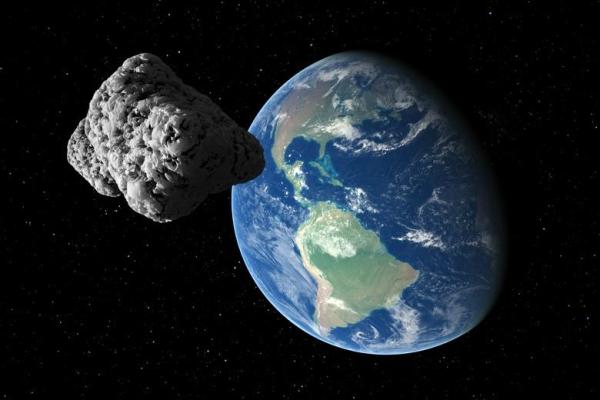Wake up call for earth after near miss with asteroid.
Sat 18 Mar 2017, 15:21:42

Another Near-Miss Asteroid Scare: Discovered Only 10 Days Before Today’s Fly-By
And yet another large asteroid has buzzed Earth this year, this time passing by on March 17, just in time for St. Patrick’s Day. That’s the good news. The bad news is that it — designated asteroid 2017 EG3 — was only discovered 10 days prior to its passing.
Asteroid 2017 EG3 managed to escape detection for centuries as it crossed the orbit of Earth twice in its own elliptical two-year path around the Sun until the Mt. Lemmon Survey observatory, located outside of Tucson, Arizona, first sighted it on March 7, according to the Daily Mail. Regardless, the asteroid made its near-miss fly-by of Earth on St. Patrick’s Day at a distance of four lunar distances (a lunar distance is measured as the distance between the Earth and Moon), or at 0.0112047 astronomical units (or AU, the distance between the Sun and Earth). For the layman, that is just over a million miles (1.6 million kilometers).
The latest addition to the Near-Earth Object Program catalog kept by NASA, monitored to assess the likelihood of terrestrial impact, measured just over 75 feet (23 meters) wide, a size half that of the meteor that caused the Tunguska Event in 1908. Although not considered a threat currently, 2017 EG3 could one day pose a potential threat to Earth.
Stanford University physicist Roger Blandford, writing for Space News in September 2015, explained, “An asteroid much smaller [than those 140 meters (460 feet) wide — and larger — given priority by Congress to be found], just 45 meters (150 feet) across, exploded in 1908 over Tunguska with an explosive energy of several megatons and destroyed an area as large as New York City. Congress calls these smaller asteroids ‘city killers,’ and although they are 30 times more numerous, we have located less than one percent of them.”
There is an estimated 2,300 hazardous asteroids (460 feet — 140 meters — or larger) still undetected in the Solar System, according to a 2016 report by the White House’s National Science and Technology Council. [Image by Nostalgia For Infinity/Shutterstock]
The near-miss fly-by of asteroid 2017 EG3 is just the latest in a flurry of recently discovered
near-Earth asteroids making close passes. Perhaps the most discouraging was the passage of 2017 EA, a space rock that breached the ring of satellites orbiting the Earth a mere six hours after being detected. The asteroid, which measured just 10 feet across, came within 9,000 miles of the Earth.
near-Earth asteroids making close passes. Perhaps the most discouraging was the passage of 2017 EA, a space rock that breached the ring of satellites orbiting the Earth a mere six hours after being detected. The asteroid, which measured just 10 feet across, came within 9,000 miles of the Earth.
But it is these close encounters with asteroids that are being detected within only hours or days of passage — or even potential impact — that worry the scientific community, because although there is a rudimentary system in place to monitor known asteroids and comets, the task of discovering the enormous number of potentially hazardous objects is daunting, the methods of discovery insufficient to the task. And even if an object the size of a “city killer” were detected, there isn’t an asteroid defense system ready to deflect or destroy the incoming object.
An in-place detection system would become the first line of defense against dangerous objects headed toward Earth. Such a system could serve as a much-needed early-warning aid to prevent surprises like the Chelyabinsk meteor that detonated in the skies over Russia in February 2013. That object, estimated to have been over 65 feet (over 20 meters) wide, exploded with 26 to 33 times as much energy as that released from the atomic bomb detonated at Hiroshima. As it was, the meteor detonated roughly six miles up in the atmosphere but the shockwave still sent over a thousand people to the hospital and damaged thousands of buildings.
And it came without warning, flying out of the direction of the Sun.
Asteroids just 45 meters (147.6 feet) wide can potentially impact with enough force to destroy an area as large as New York City. [Image by solarseven/Shutterstock]
This is not to say that asteroid 2017 EG3 would have been any type of killer asteroid had its near miss become a direct or glancing hit. Too little is yet known about it. Besides, the ultimate effect of impact of any given object is dependent upon several factors, such as speed, angle of insertion into the Earth’s atmosphere, composition of the object, and the location of impact. Needless to say, impacts on land and near large population centers would be far more devastating than landfall over deserts, Antarctica, or the oceans.
No Comments For This Post, Be first to write a Comment.
Most viewed from Specials
Most viewed from World
AIMIM News
Latest Urdu News
Most Viewed
May 26, 2020
Which Cricket team will win the IPL 2025 trophy?
Latest Videos View All
Like Us
Home
About Us
Advertise With Us
All Polls
Epaper Archives
Privacy Policy
Contact Us
Download Etemaad App
© 2025 Etemaad Daily News, All Rights Reserved.













.jpg)
.jpg)
.jpg)
.jpg)
.jpg)
.jpg)
.jpg)
.jpg)
.jpg)
.jpg)
.jpg)
.jpg)

















